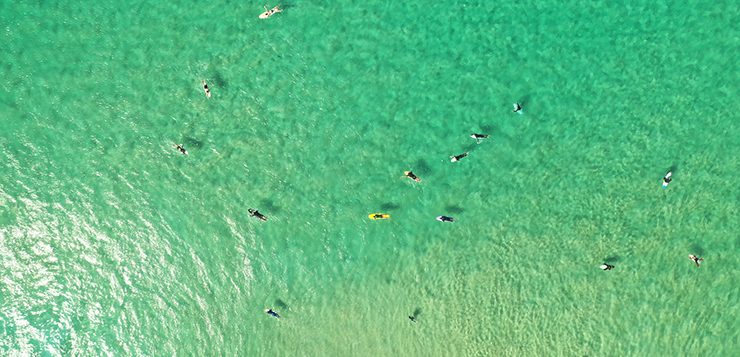Yes, readers, the tinsel’s on the wall and the reindeer are thirsty. It’s summer and we’ve gathered the freshest commentary on the Australian arts scene to tide you through the holiday period. This year, we’ll be staying in our own backyard as we examine local practices and local content.
We asked our writers to reflect upon the gaps they perceived in Australian cultural coverage. What stories don’t get told in the weekend arts supplements? How do artists, storytellers, theatre practitioners, writers, zine-makers — the whole circus — stay energised in a political and economic environment which is often hostile to the arts?
What has emerged is a set of interconnected reflections on the relationship between culture and place which add up to a series of pointed arguments about how cultures get made and remade. You’ll read NM regulars, established writers, and emerging voices as they explore the ways in which local content is produced. They don’t always agree with each other — and we’re sure that you’ll find new perspectives to ring your sleigh bells.
Just as Christmas is the season for separating those who are naughty from those who are nice, opinions are split on the nice v. naughty question — or rather, the nice v. edgy question, especially on the small screen. While Kyle Sandilands did a fair job of making the airwaves unsafe for radio listeners, in 2009 big debates were generated by locally produced TV. Mel Campbell tackles the rise of new kinds of edginess on Australian television, looking at the way the edginess can be used to defend both socially corrosive, offensive manifestations of edginess and instances of free speech-wielding smartarses. Where are the lines drawn between these two poles? One woman’s Safran, after all, is another’s Sam Newman. The defence of artistic freedom — not quite the same beast as edginess but not unrelated either — was raised with reference to Roman Polanski and many others this year. Judith White reviews some of the fraught encounters between artists and morality in 2009.
TV critic Sue Turnbull clocked a rise in edginess but nonetheless declared 2009 a winner for niceness, with Masterchef the nice-as-pie TV surprise success of the year. Don’t ask Ben Pobjie what he thinks about all this. He’s sick of the syrupy niceness that’s corrupted our proud television tradition. When they start cutting off fingers in the Masterchef slice and dice challenge, he’ll tune in.
While Australians love a local cooking competition, we’re not, apparently, so keen to embrace local pop and R&B artists, writes Clem Bastow. It’s been hard to keep up with the music business. There’s an endless archive of new releases, rereleases and commentary online: it’s getting hard to be a qualified niche listener, let alone an expert, argues Ben Gook.
We don’t know if it was the rise of Masterchef that heralded the significance of food to Australian culture but in 2009, everyone, it seemed, wanted a suck of the sauce bottle — and then everyone wanted to talk about it, blog about it, tweet about it. Melissa Leong explores the new food communities being built online. Parallel to these social formations emerging around food and eating, there’s a welter of new books about what Caroline Hamilton terms “food consciousness” available which prompt readers to consider not only what they’re eating, but why.
These new ways of thinking about food are what drives us to farmers’ markets, local cuisine and community gardens, writes Rebecca Varidel in her review of the renewal of interest in local produce. Jennifer Hamilton is also interested in local produce, but her eyes are on the challenges — and rewards — of staying local for Australian artists.
Luke Miller has seen the future of cinema — and it’s got blue skin. If you manage to avoid strapping on a pair of 3D glasses and seeing Avatar this summer, you’ll miss out on the chance to assess whether Miller is right or not to claim that the film is an argument against interplanetary travel.
Last year, the elephant in the cinemas was Baz Luhrmann’s Australia. What was all the fuss about, wonders Bruce Isaacs as he looks back on a year in the film industry. Maybe our cultural saviour won’t alight in the form of a blockbuster movie after all: imagine that. Speaking of cultural saviours, the Australian art market appears to have survived the GFC without too many bruises. According to Andrew Frost, an opportunity has been missed to clean up some shady dealing in the industry.
The end of this year has seen a surge of impassioned discussion about the lack of women in key creative positions in Australia’s major theatre companies. Augusta Supple reports back from the industry talk-fest on the matter. It’s not just women who are being left off the main stages of Australia, writes Jana Perkovic. The programming of the big theatre companies gives a poor indication of Australia’s vibrant, internationally renowned performance scene — and does little to engage with the diversity of contemporary Australia.
As Ben Eltham writes in his analysis of reviewing culture in the broadsheets, “bashing the Australian screen industry is something of a national sport just now.” Bashing the arts is as Australian as sunstroke — and often, the best arts-bashers are those who work in the arts. While regulators, funding bodies, audiences and artists of all persuasions come in for some criticism through the course of this series, you’ll also read stories about what’s going right.
There’s an explosion of urban art in the back streets of Australia’s cities. Matt Levinson will take you down some alleys that have been reinvigorated by community artists. Louise Hawson started looking more closely at Sydney in 2009 and has been documenting her discovery of the beauties of suburbia in her blog 52 Suburbs.
It’s easy to complain about working conditions for creatives — but what if you can’t even find working conditions to complain about? Ozlem Eskicioglu writes about the frustrations of being the work-experience kid and about setting up a magazine to avoid the coffee rounds and to get some practical experience. Glen Fuller reviews a new book which takes a different approach to solve the difficulties of working in the business of knowledge and creativity: leaving a think tank to run a motorbike workshop.
Arts and artists can catalyse real changes of consciousness, claims Sue Jackson. It was a poet who made her rethink her relationship to the Yarra River and it is the acquisition of this new kind of empathy, she argues, that will help up to shift our behaviours and tackle climate change. This capacity for creative thinking to yield sustainable alternatives to current practices also interests Anna Tweeddale, who explores the innovative responses of designers to the technological problems we face in an era of climate change.
There’s been plenty of ominous rumbling about the future of print media throughout 2009. Is the internet killing the newspaper? Is blogging killing journalism? Has any death-in-progress been so heavily reported and in such hyperbolic terms? Barry Saunders not only reckons journalism is alive and kicking, he’s unconvinced that so-called new media forms are that new at all.
Just as newsprint enthusiasts have worried about the web, the printed book has apparently been under assault — on the one front from the Productivity Commission and on the other from the Kindle. Zines and underground publishing are powerful antidotes to alarmist narratives about the disappearance of print, writes Jennifer Mills. The odd and ephemeral nature of zines are also explored by Vanessa Berry, who argues that their very oddity and ephemerality are responsible both for the charm of the medium and its uneasy fit into literary institutions.
For all that our writers are representing a vibrant and diverse set of Australian cultural practices in this series, Dan Edwards isn’t sure that the message is being communicated adequately abroad. Writing from Beijing, he diagnoses a failure of cultural diplomacy which, he argues, doesn’t just sell our artists short, it undermines our diplomatic efforts.
This year, we introduced a new section: the 20 Questions Challenge. The secret trivia topics of newmatilda.com writers and friends were revealed and we got a karaoke list for our office Christmas party. For summer, we’re experimenting with crowd-sourcing: we’ve handed over a special festive edition of 20 Questions to our Twitter followers. You’ll read the best answers to the great questions of our time in 140 characters or less over the next few weeks.
And finally, fear not, we have not neglected to provide you with fodder for festive family disputes about a key seasonal question: when will the second decade of the millennium really start? Lindsay Foyle will bat for 100 and give you the answer on New Year’s Eve.
Happy New Year!
Donate To New Matilda
New Matilda is a small, independent media outlet. We survive through reader contributions, and never losing a lawsuit. If you got something from this article, giving something back helps us to continue speaking truth to power. Every little bit counts.




